Alarm clocks are awful. Get one of these instead.
Even if your alarm clock is one of those Zen alarm clocks with melodious metal chimes, or it's your phone playing New Age music at gradually increasing volume, an alarm clock is still not offering you anything. It's just invading your rest and causing you to start your day with a little slap of sadness and irritation, arguably made even worse by the snooze button's empty gift of a few more minutes of half-sleep. Which you'll probably only spend trying to integrate your interrupted dreams with wakefulness.
(It is, at least, pleasant when I realise for the umpteenth time that I am not, in fact, still in high school.)
Or you may just lie there, living in fear of the return of the cursed alarm.
I shudder to think how much human misery those millions of little morning insults have added up to, over the centuries since humans first invented a water clock that would make a noise at a particular time.
Presuming you can't just rearrange your life so it doesn't matter when you get up, the best option in the pursuit of timed wakefulness is, clearly, a butler. A butler who brings you a cup of tea, even as he murmurs his apology for the regrettable necessity that you be conscious.
(The celebrated Stephen Fry alarm clock seems to no longer be in production, and it would also appear that more people paid for them than actually, strictly speaking, received a product in return. One can only hope that the Bible-verse version of the same product is similarly defunct. I would very much like to see a combination of the two.)
Failing that, what you want is a teasmade.
This one's mine. It's not a particularly elegant or collectible example, but it does the job.
The modern teasmade - the term has become a genericised trademark, in Britain at least - is essentially an electric kettle controlled by an alarm clock. When the alarm time is reached, the kettle element turns on, and a few minutes later boiling water is delivered to the tea-leaves.
Or to anything else you put in the little teapot, for that matter. If you want alarm-clock instant soup or Bovril or anything else you can prepare by putting it in a pot and pouring boiling water on it, you can have that too. (Might be a bit of a challenge eating soup out of the little teapot, though, if there are bits in it too big to exit the spout. You could also make a hot-milk-based beverage in a teasmade. But possibly only once.)
Most Automatic Food Machines, especially the ones that look like the coolest thing in the universe, have problems. They don't work in the first place, or they work only for a little while without unfeasible amounts of maintenance, or they're uncleanable, or their sole desire is to maim or murder their operator.
For every good gadget like the blade meat tenderiser or Aeropress coffee maker, there are a dozen crappy As Seen On TV wastes of time and money.
(There's also a small sub-category of wonder food gadgets that can only work by breaking laws of physics.)
A teasmade is not like that.
It is easy for a tired person to set up of an evening, it does what it's supposed to do without fuss, it has no moving parts except the control buttons, and its cleaning requirements are close to zero.
(Classically, you are never meant to do anything more than rinse a teapot; the accumulating tannin stains are supposed to make the tea taste better, though I'm pretty sure that claim doesn't stand up to double-blind testing. If you've got unusually hard water or use a teasmade for a long time then you may also need to clean lime-scale out of the boiling vessel and tube, but just running the teasmade with water and vinegar in the boiler should take care of this.)
The earliest alarm-clock tea-makers were created in the late nineteenth century. They were shiny and clockwork, with alcohol burners and a match-striker or other similarly implausible mechanism to light the burner when the alarm went off. These devices were less of a threat to life and limb than one might imagine, but were still less than entirely convenient to operate, and also rather expensive. And, to be fair, if there's one thing that'll wake you up even more effectively than a nice cup of tea, it's a fire on your bedside table.
The modern teasmade is electric, safe and reliable, and quite cheap. I bought mine used on eBay in 2003, and it cost me only $AU37.85 delivered. That was an unusually good deal - one just like it is on ebay.com.au as I write this, for $AU90 plus delivery - but working and pretty-safe-looking used teasmades routinely sell for well under $US100 delivered, and you can get a brand new one for less than 60 UK pounds delivered within the UK, $AU160-odd delivered to Australia, or around $US165 delivered to the States. Or less, if you buy the version with no radio, of which more shortly.
And yes, American buyers are likely to have voltage problems, because the teasmade is largely unknown outside the UK and as far as I know nobody makes a 110-volt one. More about that in the "buying one" section, below.
How it works
As you can see in the above picture, the modern teasmade really is essentially just a combination of an alarm clock - often, as in mine, a clock-radio - and an electric jug. It's quite easy to use.
The alarm clock in my teasmade works in the same way as every cheap plastic clock-radio. You set the time, you set the alarm, you tune the radio, and you select how you want the thing to wake you up.
In addition to the standard clock-radio options of an awful alarm noise or a tinny radio, though, my teasmade lets you select "tea" alone. You will then be awakened by the sound of boiling water, and the smell of a mildly caffeinated beverage.
My teasmade is rated at 600 watts at 240 volts, which is on the low side by electric-jug standards; here in Australia our mains electricity is a nominal 230 volts and a usual actual 240, so electric jugs with a power rating of 2000 watts or more are common.
My teasmade's water capacity is only about 650 millilitres - that's about 2.6 metric cups. Or a couple of good-sized mugs, or more than three dainty little teacups. The 600-watt heater takes about seven minutes to boil this full capacity; proportionally less if you don't fill it completely. You should of course take account of this boiling delay when setting the alarm time.
The initial heating process is quiet; it'd probably wake me up if I were sleeping without earplugs, since I'm a pretty light sleeper, but most people would sleep through it. The part where the boiling water is transferred to the teapot, though, is quite dramatically loud, and should be an effective alarm for most people all by itself.
The reason for the noise is the way in which my teasmade, like pretty much all others, transfers the boiling water from kettle to teapot. When you put the filling cap back on the boiling vessel, the boiler is sealed except for a metal tube that goes almost to the bottom of the vessel, and arches over to point at the middle of the lid of the...
...distinctive hole-topped little teapot. (If you find a junk-shop teapot that looks like this, you now know where it came from.)
When the water boils, the pressure of the steam pushes the water through the tube and into the pot. It takes no more than ten seconds for my teasmade to transfer a full pot-worth of water through the rather narrow tube. Hence the noise. When the reservoir's empty, it heats above the boiling point of water and a thermostat shuts off the heater. (There's also a switch that disables the heating element if the teapot isn't in place, so night-time absent-mindedness will not result in an unconfined spray of boiling water the next morning.)
If you need more of an alarm to wake you up then, ideally, you'd be able to set the horrible alarm noise or irritating radio station of your choice to go off when the water transfers, or even after the tea's had a few minutes to steep. But my teasmade can't do that; the alarm/radio goes off when the heating element turns on, at which point a single cup of tea is at least five minutes away, and a full pot is at least seven.
Some teasmades have more sophisticated alarm settings, so the alarm can go off when the boiling is completed, not when it starts:
OK, that alarm takes us straight back into the Land of Horrible Awakenings. But at least there is tea.
Going along with its cheap-clock-radio nature, my teasmade has no backup battery, and reverts to that good old flashing "12:00" and no memory of previous settings if there's even a momentary power cut. You can solve this problem by running the teasmade, and for convenience also your bedside lamp, from a small uninterruptible power supply. A pretty beefy UPS will even be able to run the tea-making element; a cheap one won't be able to do that, but will at least ensure continuity of timekeeping if the element doesn't try to click on from UPS power.
I'm hardly an authority on teasmades, though; there are a lot of different models, even if you disregard the pre-electric W. Heath Robinson versions.

(Image source: Flickr user James Mooney)
Here's a Goblin with a removable boiler, as well as teapot, presumably for ease of filling.

(Image source: Flickr user James Mooney)
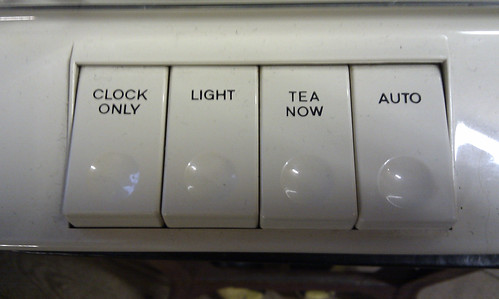
(Image source: Flickr user Martin Deutsch)
I wish mine had a TEA NOW button.

(Image source: Flickr user leo.j.turner)
Another picture of the same model of teasmade, or at least one with the same buttons. It appears to have won an award. Good for it.

(Image source: Flickr user MarkyBon)
This one just screams Fawlty Towers.
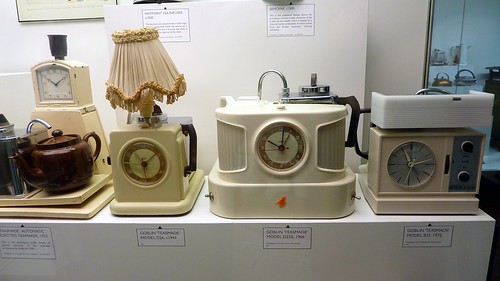
(Image source: Flickr user gruntzooki, a.k.a. Cory Doctorow)
Another just like it, and some others, on display in the London Science Museum. It's apparently circa 1945.
The integrated lamps can be rather nice:
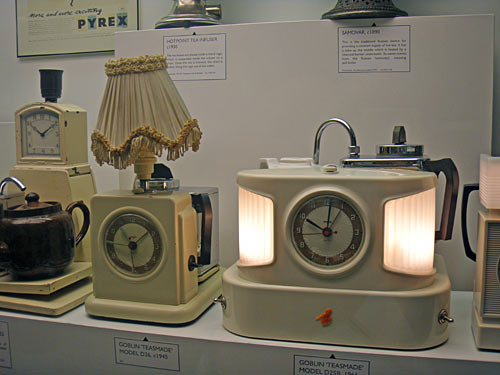
(Image source: Flickr user ebbandflo_pomomama)

(Image source: Flickr user Simon Harriyott)
This one looks as if it ought to be mystifying Jacques Tati in Play Time.
A simple search for "teasmade" (which may or may not correctly geo-target to your country; here the same search is on eBay UK, and here it is on ebay.com) gets 20 relevant hits on eBay.com.au as I write this, plus a few isolated teapots and a Bjork remix with "Teasmade" in its title.
There are some decent deals there, but I probably got my teasmade so very cheaply - under $AU40 delivered - because it was described as "Alarm clock/radio with teapot -RARE", which barely describes it and is almost impossible to search eBay for. I've no idea how I ever found it.
Even if all you throw into the eBay search box is some generic "tea maker" sorts of terms, it's pretty much impossible to filter out umpteen ordinary electric jugs, teapots with infusers in them, teapot-shaped kitchen timers and so on. Here's my best effort at making such a search across the whole of eBay.com.au with possible geo-targeting to other eBay sites; if that doesn't work, here's one for ebay.co.uk and here's one for ebay.com.
The easiest way to get a teasmade today is to just buy one new. For a while I think this may have been impossible unless you found a dealer with "new old stock", but now it's quite easy to buy a Swan teasmade online.
You may or may not care for the Swan's magic-lantern styling and LCD analogue clock, but on the plus side, you know the appliance hasn't been sitting in someone's garage for fifty years, maturing into a truly world-class fire hazard.
The Swan teasmades list on their site for £79.99 (about $US128 or $AU124, as I write this) ex delivery. They don't ship outside the UK, though.
The Swan teasmade is also on sale at this Union-Jack-waistcoat of a site, which is very excited to announce that the "Teasmade Classic is now £48.99 and the Radio Teasmade is now £69.99!". But they, also, only ship within the UK.
There are Swan teasmades on eBay; a US buyer could get the basic no-radio model for $US132.05 plus a mildly suspicious only $US6.00 for shipping, and an Australian shopper could get the same model for $US142.05 delivered.
That's not cheap, but at least the Aussie shopper would only need a plug adapter to connect a UK-sourced teasmade to Australian mains power.
(Until quite recently, it was normal for UK appliances to come with a power cable that terminated in bare wires, because the UK contained an incompatible mixture of the old BS 546 and new - in the sense of "after World War II" - BS 1363 wiring and plug standards. You had to buy a plug separately and screw it onto the cable yourself, or get someone in the shop to do it for you if you were a wuss. Nowadays BS 1363 is dominant enough that I think pretty much all UK appliances come with a BS 1363 plug moulded onto the end of the cable. Chopping that plug off and replacing it with one to suit your own country's mains, so you don't have to use an adapter, is unwise if you don't know what you're doing, but is legal in most countries.)
If you live in the USA, Canada or some other 110-to-120-volt country, though, you have a problem. Some teasmades wired for 110V are alleged to exist, and converting one wouldn't be an insoluble problem for an electronics hobbyist or repair-person, but you ain't gonna get one off the shelf.
So there's nothing stopping someone in the Americas from buying a teasmade from the UK or Australia, but it'll be the wrong voltage and you'll have to run it from a quite beefy step-up transformer.
Your beefy step-up transformer will very probably be an autotransformer, and very probably come with a piece of paper listing a wide variety of devices they strongly recommend you never plug into it on account of autotransformers' poor isolation qualities. A teasmade is likely to fall into at least two of those forbidden categories.
That said, two-pin sockets and cheater plugs do not yet seem to have killed most of the American population, and those are more straightforwardly dangerous than a teasmade running from a step-up transformer. Modern teasmades also have no exposed metalwork, so you're not really living too dangerously if you use one from a step-up transformer. I'd do it. But I am known for making poor decisions.
You can also get fully electrically isolated step-up transformers; they're more expensive, but solve the safety problems. And if your American house has a 240-volt circuit for a clothes-dryer or other high-powered electrical appliance, you can just plug the teasmade into that. (Running an extension cord from the one 240V outlet in the bathroom all the way to your bedroom may negate the safety benefit.)
The frequency of US 240V will be 60Hz instead of the 50Hz the teasmade expects, which will cause old-style electric clocks to run six-fifths as fast as they should. If you get an old teasmade with an analogue clock then there's a good chance it depends on the mains frequency to keep time, and will thus be essentially useless from the wrong frequency. You could run it from a frequency converter, but by now we're getting well out into the crazy-weed.
As long as there's no mains-synchronous clock in your teasmade, a different mains frequency shouldn't be a problem. A newer teasmade with a digital clock will very probably have a quartz oscillator that's immune to mains frequency changes.
Alternatives
By this point, American shoppers intrigued by the teasmade idea but disinclined to subscribe to British Appliance-Fancier Monthly will probably be thinking there must be a simpler way to do this. I mean, you could just plug an electric kettle into a timer switch and get something approximating the same functionality.
It occurs to me that if you get a coffee-maker that has a timer function, put tea leaves in it in place of coffee (and, if you want to get fancy, also replace the paper filter with a mesh strainer screen), you could get very close to a teasmade's functionality without all of the international-voltage bother.
The design of the typical modern no-moving-parts bubble-pump coffee-maker (which, incidentally, uses as a pump the same sort of device that propels a pop-pop boat)...
...is not ideally suited to making tea, but it'd more or less get the job done. A coffee-maker may not quite make Tea According To Orwell, but I'd drink it.
(Oh, and cheap drip coffee makers' primary purpose appears to be to make coffee snobs almost as apoplectic as percolators do, but a teasmade actually makes pretty close to optimal tea. It doesn't pre-heat the teapot, which is a mark against it, but it does deliver really scalding water onto the tea leaves, which is generally agreed to be Correct. Coffee benefits from being made with less-than-boiling water; tea does not. The fact that water boils at only 174°F at 20,000 feet {79°C at 6100 metres} is clearly a far greater problem for British mountain-climbers than any piffling shortage of oxygen.)
Cheap coffee-makers with timers require you to reset the timer every night, because they can't tell whether there's already coffee in the carafe or not, and want to avoid disasters that a forgotten full carafe could cause the next morning. (Leaving the water reservoir empty shouldn't be a problem, though, because even the very cheapest of coffee-makers should have a reliable overheat cut-off.)
You'd think you could get a coffee-making teasmade-analogue with an actual alarm-clock brewing function for a reasonable price, but I'm not sure if you can. I think you can do it with expensive plumbed-in models like this one, but few mere counter-top models seem to have such a feature.
I think this inexpensive Black & Decker model may qualify, though. I managed to find a manual for it online and it does seem to have a repeating alarm-coffee function. If you definitely know of such a thing, please do tell us all about it in the comments.
(On the subject of different approaches to the problem, check this out. Once again, some concept designer has supported my previously-expressed opinion of the breed, in this case by reinventing the teasmade and making it much, much worse. Apart from apparently being carefully designed to set itself on fire from the middle out, this concept design expects you to, first thing in the morning, drink tea out of a hemispherical E-Z Spill(TM) cup with no handle. This design also requires you to put a tea bag in cold water the night before and let it sit there for hours before the water is heated, which I can only presume will cause the ghost of Queen Victoria to manifest, reach into your chest and crush your worthless heart.)
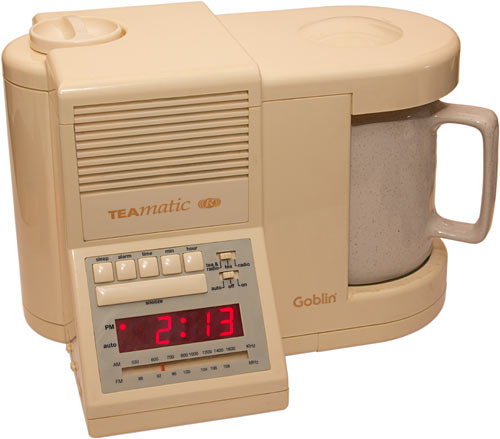
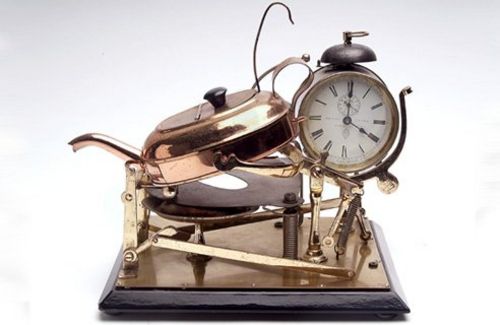
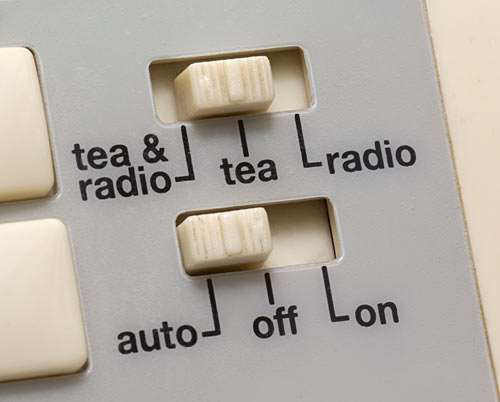
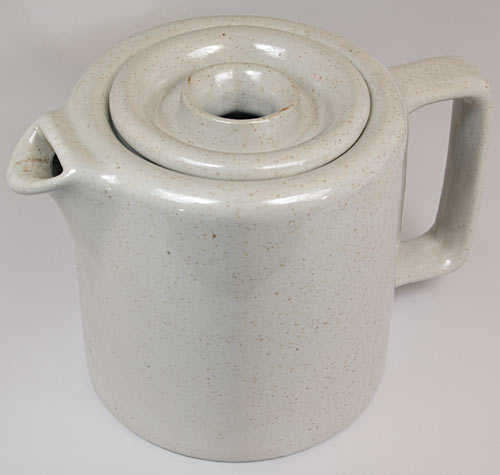
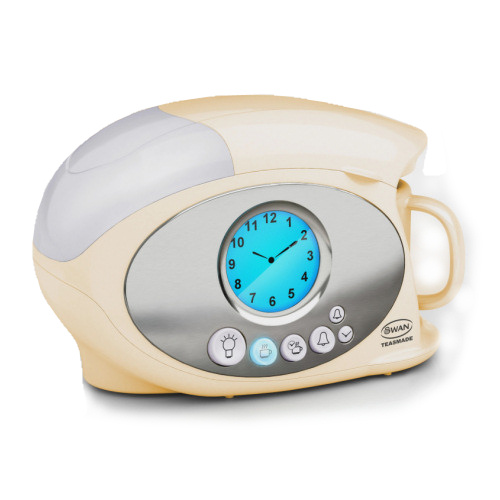
24 October 2012 at 9:52 pm
I registered with WordPress just to post this comment.
[MRS DOYLE]But I LIKE the drudgery of making tea![/MRS DOYLE]
(sadly I can't find a suitable video right now, but it was a Father Ted Christmas Special)
24 October 2012 at 11:45 pm
I seem to be posting here weekly now, but actually you do seem to have missed the most basic approach to coffee maker alarms: timer plugs. Get one of the cheap ones with the rotating dial and the pins, stick your (drip) coffee maker in that and make sure it's off at the time you put the coffee in and turns on when you're supposed to get up.
My mother used this successfully for years as a way to have coffee right after she got up, which for her was a matter of necessity.
25 October 2012 at 9:08 pm
I actually did mention that. I do not blame you for failing to find that among the alarmingly large amount of other words I found to say about alarm-clock tea-makers.
25 October 2012 at 9:22 pm
Oh I guess you did.
My point is also you don't have to reset the timer at all. Most of them can turn on at some point and turn off at another. Add a cheap drip coffee maker that's always in "on" mode and set it up the night before. Having a full can left over would not be a problem, considering this is something you spot when you put the water in for the next day.
So I don't really know what the added benefit of coffee maker with alarm clock function is. In fact, knowing the quality of most drip coffee makers it'll just blow up slightly quicker than other models.
25 October 2012 at 12:52 am
In my experience (in Canada), pretty much any drip coffeemaker that features a digital clock will also have an "auto" setting that lets it turn on at a specified time (and that remembers that time for the next day) - so you shouldn't need to re-set the alarm time each day.
Such coffeemakers start about $40 and run up from there. The cheapest drip coffeemaker without a clock at all can be had for about half as much.
C.
25 October 2012 at 2:01 am
In my experience in the USA, it's hard to purchase a coffee pot that doesn't have a built-in timer to make coffee at a specified time.I bought one for under $15 US just last year.
25 October 2012 at 2:40 am
I've got to say that in my lifetime (I'm 28) I can't think of a single appliance that I've HAD to wire a plug for. So its not that recent a thing.
Our first year physics class was one of the last to feature the lesson on how to wire a plug (probably one of the few useful things taught there) and lead to our year becoming incomprehensibly old while at school by saying "back in my day we used to get taught to wire a plug!".
25 October 2012 at 2:52 am
Indeed, the typical American coffee maker comes with a timer function - and typically you needn't worry about terrible overflow accidents because you typically fill the reservoir of the coffee maker with water measured out from the carafe! Ergo, the likelihood of a full boiling chamber with a full carafe in place is minimal.
I have recently upgraded, thanks to the generosity of friends and family at birthday time, to a Keurig machine. I find most of the pre-packaged Keurig cups of both coffee and tea to be terrible... but they do make a "fill your own" Keurig cup with which excellent results are possible. I alternately fill it with Irish Breakfast Tea or a nice French Roast coffee. With its timer I wake up to a nice big cuppa every morning. Good thing too - I am not a pleasant person prior to a bit of caffeine.
25 October 2012 at 4:56 am
The last office job that I worked had a Keurig machine with a stop brew button. I discovered that stopping the process at half a cup, then changing to a new cartridge, and brewing again (stopping at half, again) made a nice strong cup of coffee. All the IT guys started doing it that way. A bit wasteful but worth it on the company dime.
25 October 2012 at 7:50 am
Wasteful? Depends on the point of view... by the time it's reached half-brew almost all the caffeine is already out, further brewing just modifies flavour and concentration. Swapping out the cartridge effectively doubles the caffeine in the resulting brew. So if your goal is just to keep yourself awake, you're simply using the coffee in the proper way.
I thought I was getting more wakeups (that's a SI unit) from my coffee by running my espresso machine's pump longer; I assumed the resulting watery coffee also contained more caffeine. It was explained to me that this assumption is wrong, and all I was doing was brewing bad coffee. Since then I've taken to just filling the filter with twice as much coffee and using 100% robusta, which tastes noticeably worse but has twice the caffeine content than arabica. By doing this I can make a small cup of almost-explosive coffee containing enough caffeine to get me through most of the afternoon.
26 October 2012 at 1:17 am
Well, if you are just looking for Caffeine content, may I present the Black Blood of the Earth.
Caffeine is intentionally capitalized in the last sentence - read the link to see why. I'll wait...
K, so now you know that this is coffee but it has as much as 40 times more caffeine than normal. Thus "Caffeine". I have actually had this stuff (specifically the Kona)....and it is excellent. Both for the ability to keep you awake through to the heat death of the universe as well as tasting great. Bit pricey though.
28 October 2012 at 1:28 am
I see "regular coffee" under the picture of a canned beverage from Starbucks. This is blasphemy. Regular coffee around here is concentrated spoon-dissolving stuff.
That BBotE stuff looks interesting, but there's no way that price is justified. A triple-shot of 100% robusta WILL keep you wide awake without costing as much as snob-quality liquor.
25 October 2012 at 3:12 am
Your quest for a 120V equivalent to the Teasmade inspired me, and this pricey but intriguing Breville BTM800XL model seems to fit the bill (Amazon link; feel free to munge it for affiliate-money, Dan).
model seems to fit the bill (Amazon link; feel free to munge it for affiliate-money, Dan).
It's got good ratings, but more importantly, a magnetically-suspended moving tea-infusion basket, so basically all nerds must immediately purchase it.
The "related items" will lead you to a plethora of other automated tea-makers, and I assume most have a teasmade function, and all should work with 110/120V power.
26 October 2012 at 4:47 am
The 50hz/60Hz problem a sync-motor Teasmade would encounter in Leftpondia (and parts of Japan) could be solved in a couple of ways:
- Run an EU-spec online UPS off a washing machine (240V) circuit. Those put out 230V 50Hz, whatever the input frequency is. The Teasmade's 600W kettle would require a 1kVA or better UPS, but online UPSes smaller than that are few and far between anyway.
- Getting slightly crazier, to be read as "unless you know exactly what you're doing: don't", one could graft the charge circuit for a US-spec online UPS onto the output circuit for the same, but EU-spec, UPS.
- Build a quartz-referenced sine wave generator with a comparatively beefy output stage (able to deliver, say, 5Veff at 1A), and run its output through a transformer to get 230V. Wire the Teasmade to have only its clock driven by this 50Hz source, use a stepup transformer for the kettle.
26 October 2012 at 12:33 pm
I like the UPS idea, but would the frequency necessarily be 50.00Hz? If it's 49.99Hz you'll lose 17 seconds per day, if it's 50.01 you'll gain 17 seconds.
(It's normal for the frequency of whole power stations to vary considerably through the day, slower when heavily loaded and faster when lightly loaded. They deliberately artificially change the speed at other times to compensate, though, so mains-synchronous clocks may be a bit off at any given moment, but will over time not gain or lose any seconds.)
26 October 2012 at 7:12 pm
If you want to use your syncmotor Teasmade to wake you up every day exactly on the same time you'd better look into other timing sources to actually control the heater switch, and keep the clock solely for ornamental porpoises. Otherwise, setting the clock every two weeks or so, when the drift gets noticeable, doesn't seem a big deal to me.
28 October 2012 at 2:48 am
Are clocks using mains-synced motors even sold anymore? I haven't ever seen one around here and I'm, uh, un-young enough that I remember using vinyls and audio cassettes. It seems strange that the powerplants would go to the bother of deliberately changing the frequency just to compensate for the few synched clocks that remain out there.
28 October 2012 at 1:02 pm
In most countries, mains-synchronous clocks are far and away the cheapest way to get a really accurate timepiece, precisely because the power companies still very carefully regulate mains frequency - I think they're usually legally required to do so. Quartz clocks routinely drift by several seconds a week; synchronous clocks may be a bit off at any given moment, but over time are very reliable. So they're still used in all sorts of applications where this somewhat peculiar kind of reliability is needed. Not consumer wall clocks any more, but umpteen commercial and industrial applications.
Many of these applications could switch over to a finely regulated quartz clock, which would be almost as accurate and remove the possibility that the whole thing could go wrong because of a blackout, and there are also radio-sync clocks of various kinds. Frequency-regulation laws may also be relaxed in the future, and countries with flakier mains grids probably don't have such laws in the first place. But synchronous clocks are still all over the place, and equipment that includes them is still being made.
28 October 2012 at 7:59 pm
I have owned what I thought was a quartz clock alarm radio, bought in maybe 96-97? It does have battery back up (9V) so i figured that it couldn't be mains synchronous at all.
Then - i moved to the middle east and found that i had to set it forward by at least 10 - 20 minutes every day, and i would set my alarm early because inevitably it would lose another 5-10 minutes overnight.
I have since moved to Europe and in over 2 years i haven't had to reset the time once. Also haven't had a power outage - the supply here seems much more reliable than Australia. With all the wind turbines around, sometimes i worry about running out of electricity when the wind stops - luckily i can count on one hand the number of days where the wind has been below 20 knots.
29 October 2012 at 5:18 pm
It's funny you should say that, bj - I grew up in Lakes Entrance (southeastern coast of Victoria) and I noticed a considerable improvement in the power supply's reliability (outages used to occur frequently during winter storms) while I was growing up. Ironic, considering now that I can afford to buy a decent (or any) UPS, I don't need it as much as I did back then!
25 October 2012 at 8:37 pm
The older (synchronous-motor clock) models are reputed to produce rather annoying mechanical chirps and creaks in the clock drive, which make them less than ideal for putting on your bedside table. I can attest that the ~1960 model (the one with its integrated lights lit in one of the photos) my GF has does this. Enough to keep one awake unless you're totally shagged out.
And as for tea-making devices that incinerate not only the stuff meant to heat the water reservoir: in the opening sequence of the video clip for I Want To Break Free, by Queen, a Teasmade explodes. They tend not to do that, though.
The one we have does not only have a switch to detect TeapotInPlace, but the kettle and pot sit on a hinged plateau, with a switch that breaks power to the kettle when it's empty, either from blowing all its boiling water into the teapot, or from it not being filled in the first place. This switch also controls a buzzer, so that you get woken up five minutes before the tea is actually ready. The switches on the corners are unmarked, and control Tea Now and Wake Up With Tea And Light Or Tea Only respectively. I'm not sure if the buzzer was always enabled or came on with the lights, but it's wired to the lights now.
1 November 2012 at 1:51 am
I thought I'd give you a heads-up, because I posted this to MetaFilter.
6 November 2012 at 9:10 pm
The "TEA NOW" button equipped model was sold in Australia as the "Breville Teasmade Model 860D". I know this, because following my nostalgic meltdown just now, I recalled my Grandparents' c. 1970s model was a Breville. It wasn't 'till I searched for "Breville Teasmade", could I confirm theirs looked exactly like the Goblin analogue "TEA NOW" version here. Thanks Dan, another plesant childhood memory dredged up from neural archives. :)
PS
26 November 2012 at 8:07 am
Scalding hot water might work for lower quality teas, but nice tea often needs slightly less - 85-90 or so.
30 November 2012 at 6:56 pm
Tea? Please.
There are two essential fluids of science -- coffee and beer.
It is rather like having two pedals in your car -- one to make your brain go and one to make it stop going when you're finished with it.
16 April 2013 at 10:05 pm
I just found this. Thought it might be somewhat relevant.
15 May 2013 at 7:27 pm
To take this in another direction, I am not a caffeine (or related stimulant) addict, but my bread machine can be instructed to awaken me with the smell of fresh-baked bread. Sadly,it is getting old and mechanically cranky, so to do this it has to make alarming grinding noises three hours before the intended awakening time. And it is difficult, or at least medically questionable, to eat an entire loaf of bread a day. But there is something charming about enlisting a robotic bioreactor to awaken me with a lovely aroma.
15 July 2013 at 7:07 pm
Quick follow-up: I finally succumbed and bought the crazy Breville tea maker as a birthday present for my tea-loving missus. Early verdict: controlling the water temperature is a sweet feature for tea snobs, and automated steeping means I'll never be faced with a pot of oversteeped tannins again, and the magic magnetic moving basket in a clear glass carafe is hugely entertaining.
Since it steeps the tea in the same hot carafe that just took the water to whatever temperature you asked for, it's pretty much the perfect tea experience, albeit in an unorthodox fashion.
It's far from cheap, but it makes a great case for itself as the best Teasmade ever, and the only natively-120V one.
3 April 2015 at 3:32 am
Another, somewhat more modern one has just entered this household. Still with a sync-motor clock, but a less noisy one. It's the same vintage as the one stated to baffle Jacques Tati, only with lights on the side instead of on top. The kettle blows water into the spout of the pot; it doesn't need a hole in the lid.
About making a milk-based beverage, one could try using powdered or condensed milk in the pot, to which the appropriate amount of hot water is added at wakeup time. Although I remember from my youth (in the tropics, where fresh milk was hard to get and we made do with powdered) that you needed a good amount of vigorous stirring to unlump the resulting fluid. Condensed might work better.
And because the various Chinese tat bazaars cater to customers worldwide and then some, it's surprisingly easy if not exactly quick to get hold of B22 socketed LED bulbs over here in E14/E27-land